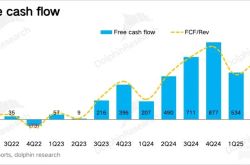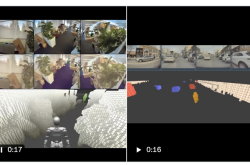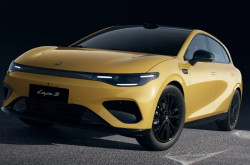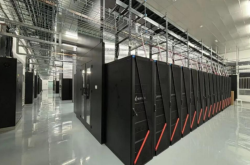Waymo Partners with Toyota to Transition from L4 Robotaxi to Personal Vehicle Autonomy
![]() 05/09 2025
05/09 2025
![]() 596
596
Produced by ZhiNeng Technology
On April 30, 2025, Waymo and Toyota announced a preliminary agreement to explore collaboration in autonomous driving technology.
The aim is to develop a new autonomous vehicle platform and integrate Waymo's autonomous driving technology into Toyota's next-generation personally-owned vehicles (POVs), signaling Waymo's strategic expansion from robotaxi services into the personal consumer market. This shift necessitates a closer look at how technology is evolving in the U.S. market.
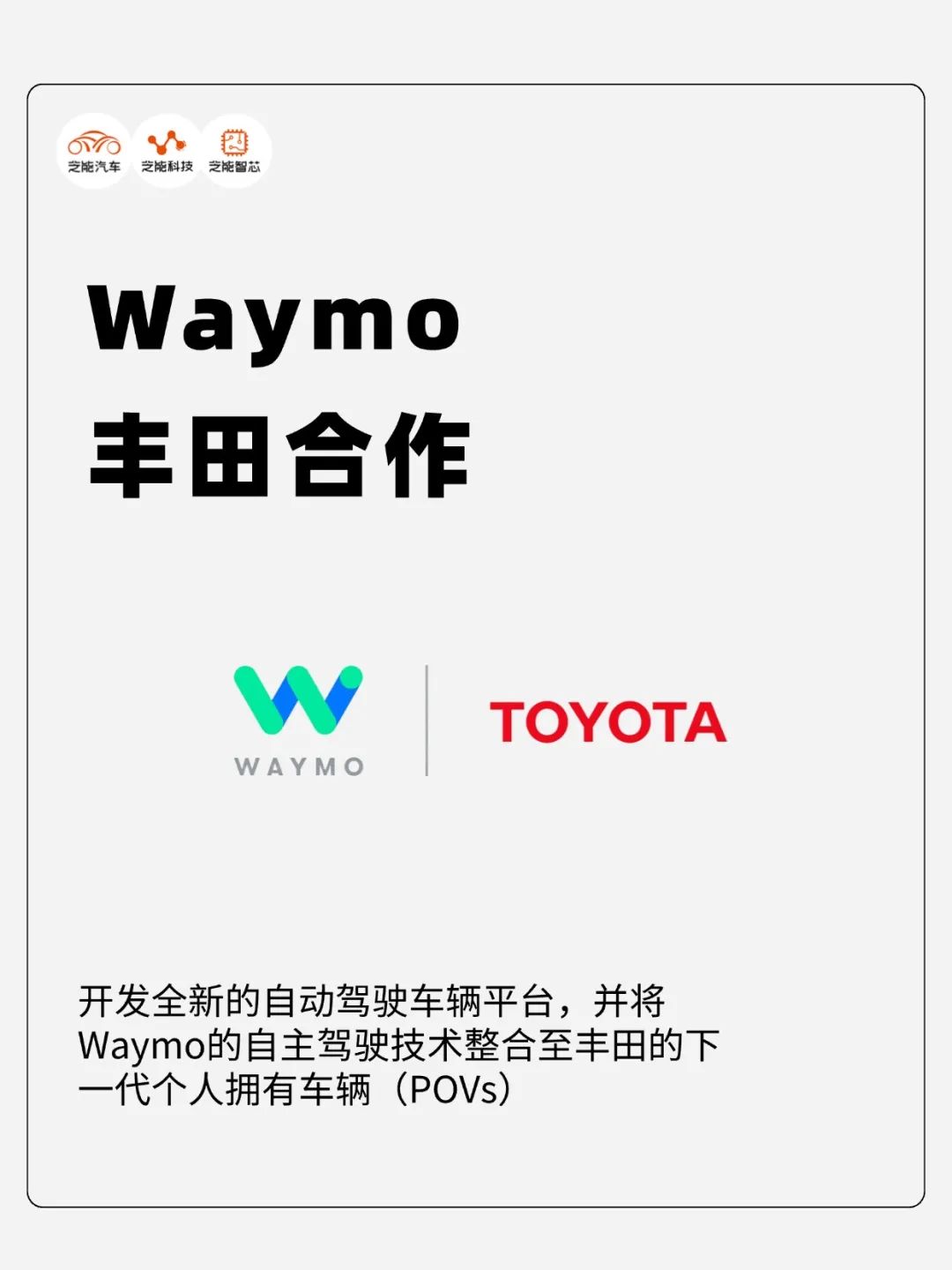
01
Background and Strategic Significance of the Collaboration
The potential collaboration between Waymo and Toyota marks a pivotal moment in the advancement of autonomous driving technology. The strong synergy between the two companies in technology R&D and automotive manufacturing aligns with the ongoing structural transformation of the automotive industry, characterized by electrification, intelligence, and diversification of travel modes.
At the heart of this collaboration lies the fusion of Waymo's strengths in autonomous driving algorithms, sensor fusion, and operational experience with Toyota's capabilities in global manufacturing, supply chain management, and product reliability. Together, they aim to explore diverse application pathways from Robotaxi to personally-owned autonomous vehicles.
Both parties have signed a preliminary cooperation agreement to jointly develop a new generation of autonomous driving platforms for Robotaxi services, with plans to extend this platform to Toyota-branded personal passenger vehicles in the future.
This collaboration will be bolstered by Toyota's Woven by Toyota department, which focuses on software development and mobility innovation, aiming to expedite the engineering implementation and commercial deployment of autonomous driving technology.
Tekedra Mawakana, Co-CEO of Waymo, stated that the collaboration's foundation is "a shared vision of enhancing road safety and expanding accessible mobility services."
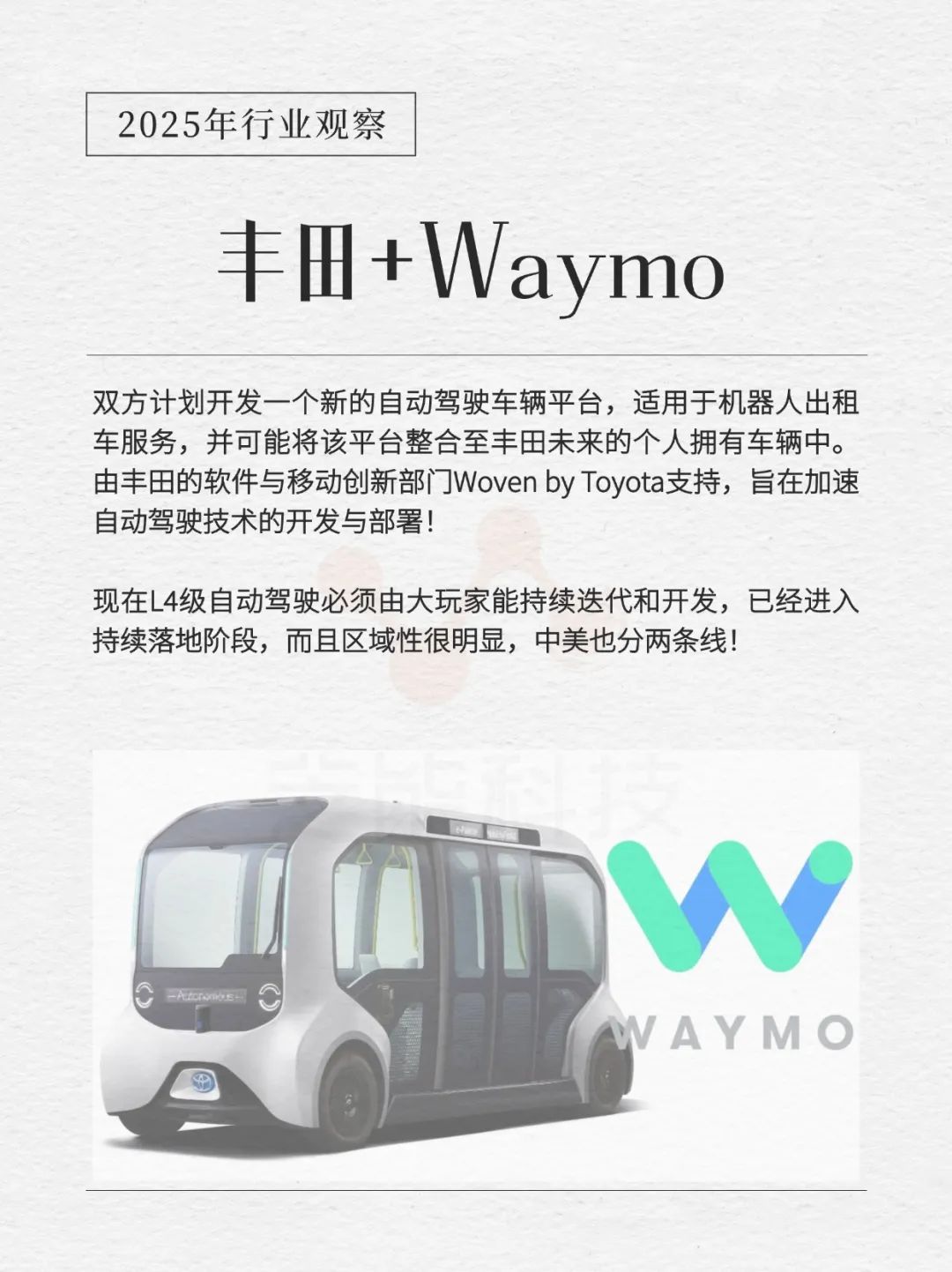
The collaboration is still in its nascent stage, with unclear agreement terms, prompting caution among observers. The vague language in the announcements from both sides makes it seem more like an exploratory "strategic engagement."
From a strategic perspective, the potential impact of this collaboration agreement cannot be overstated.
◎ Waymo currently offers over 250,000 fully autonomous commercial trips per week in San Francisco, Los Angeles, Phoenix, and Austin, leading the industry in algorithm maturity, system robustness, and operational expertise.
◎ Toyota's exceptional engineering integration capabilities, production system, and brand reliability are pivotal in advancing autonomous driving technology from small-scale commercial pilots to large-scale consumer market applications.
The commercialization of autonomous driving technology is accelerating globally, particularly in the fields of Robotaxi and driver assistance systems.
Sundar Pichai, CEO of Alphabet, publicly expressed Waymo's strong interest in personally-owned autonomous vehicles for the first time, expanding beyond a single Robotaxi service model into diverse business avenues (including technology licensing and platform building) to enhance revenue diversity and risk resilience.
For Toyota, whether it's the collaboration with Pony.ai in China or the partnership with Momenta, progress has been relatively swift. However, in the U.S., it lacks a solid footing. This collaboration in the U.S. will help Toyota address shortcomings in key autonomous driving technologies such as software algorithms, artificial intelligence, and high-performance sensors. By leveraging Waymo's technological prowess through strategic collaboration, Toyota aims to accelerate its technological evolution in L4 and beyond autonomous driving systems.
Relying on its self-developed FSD (Full Self-Driving) system and road data accumulated from large-scale mass-produced fleets, Tesla has made significant strides in AI model training and real-time assisted driving capabilities. Although FSD still requires driver supervision and falls under the L2+ category, its ability to form a closed loop with data and continuous OTA iterations has created a formidable technological barrier.
In contrast, Waymo heavily relies on high-precision LiDAR, inertial navigation systems, and high-performance computing platforms. While it boasts higher-level automation capabilities, it faces considerable pressure in terms of hardware costs and mass production pathways.
Toyota can assist Waymo in optimizing its system cost structure and increasing market penetration. Amidst the accelerating reshuffling in the autonomous driving industry and the growing dominance of leading players, the potential collaboration between Waymo and Toyota also carries significant industry signaling importance.
At the end of 2023, General Motors suspended the operation of its Cruise Robotaxi due to safety and regulatory issues and announced significant layoffs in early 2024. The business model is still in a trial-and-error phase, making resources and collaboration advantages crucial for survival and expansion.
The strategic rationale behind the Waymo-Toyota collaboration is clear:
◎ On one hand, it is an inevitable choice for technology-driven companies to expand into broader commercial applications and revenue models;
◎ On the other hand, it is the external empowerment required by traditional manufacturing enterprises in their transition towards intelligent, software-defined vehicles.
Whether the two parties can truly achieve platform co-construction and cost synergy in the future will be the litmus test for the effectiveness of this collaboration.
02
Opportunities and Challenges of Technological and Social Impacts
Waymo's sixth-generation Waymo Driver autonomous driving technology has been validated in models such as the Hyundai IONIQ 5. Its sensor suite, comprising LiDAR, cameras, and ultrasonic sensors, performs exceptionally well in complex urban environments. However, Waymo's sensors are costly, with early versions priced in the tens of thousands of dollars, limiting their widespread adoption in the personally-owned vehicle market.
Toyota's mass production capabilities and supply chain optimization can significantly reduce hardware costs, as evidenced by its successful experience in hybrid and electric vehicles.
Woven by Toyota's expertise in software development and mobility innovation will provide technical support for the collaboration. For instance, Toyota's Smart Vehicle Architecture can seamlessly integrate with Waymo's AI algorithms to develop vehicle platforms that support SAE L4 (fully autonomous driving under specific conditions) or higher levels of automation.
The two parties also plan to incorporate Toyota models into Waymo's Robotaxi fleet to further validate the technology's reliability and compatibility.
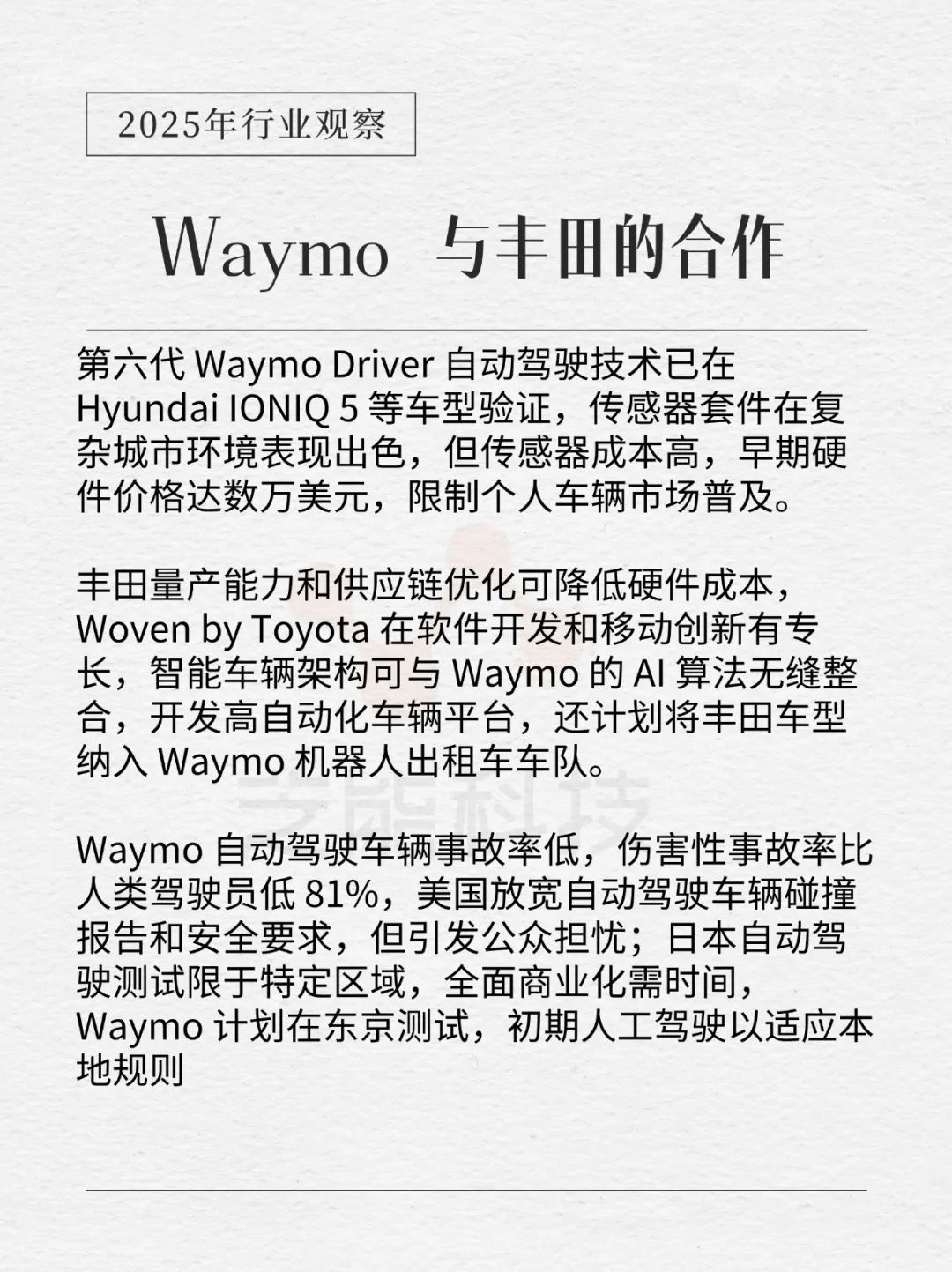
Waymo's autonomous vehicles have excelled in safety, with data showing that their injurious accident rate is 81% lower than that of human drivers. Toyota has long been renowned for its safety and reliability, and its brand image bolsters consumer trust in autonomous driving technology.
Mawakana emphasized that the collaboration with Toyota will garner public trust through global partnerships, which is crucial for the widespread adoption of autonomous driving technology.
The widespread adoption of autonomous vehicles has the potential to transform urban spaces and lifestyles. Autonomous vehicles may blur the boundaries between vehicles and residences, allowing passengers to engage in various activities within the vehicle without focusing on driving, even turning the vehicle into a mobile "living room" or "bedroom." Autonomous RVs could offer a new mobile lifestyle for the elderly, enabling them to visit relatives without leaving home. While this concept of "mobile homes" is full of imagination,
The deployment of autonomous driving technology must navigate a complex regulatory landscape.
◎ The United States has recently relaxed collision reporting and safety requirements for autonomous vehicles, offering more space for industry innovation but also raising public safety concerns.
◎ In Japan, autonomous driving tests are currently limited to specific areas, and full commercialization will take time. Waymo plans to conduct tests in Tokyo, initially with human drivers operating the vehicles to adapt to local roads and traffic rules, marking a cautious advancement of its internationalization strategy.
Tariffs and geopolitical risks may impact the collaboration process. For example, Waymo's collaboration with Zeekr was hindered by U.S. tariffs on Chinese electric vehicles, whereas Toyota's production capacity in North America can circumvent similar issues.
Market acceptance is another challenge. Whether consumers are willing to pay a premium for autonomous driving technology and how to balance the costs and functions between L3 (limited autonomous driving) and L4 (fully autonomous driving) remain areas for further exploration.
Summary
The collaboration between Waymo and Toyota essentially marks the beginning of an iteration in the U.S. market, shifting L4 Robotaxi autonomous driving technology from robotaxi services to the personal consumer market. By leveraging Waymo's AI and sensor technology and Toyota's manufacturing and brand advantages, the two parties aim to develop a lower-cost, higher-safety autonomous driving platform, thereby gaining a competitive edge against rivals like Tesla. The collaboration is still in its early stages, and challenges such as technology integration, cost optimization, regulatory compliance, and social acceptance will test the execution capabilities of both parties.





